Simon Pietersz. Verelst stands as a notable figure within the vibrant tapestry of the Dutch Golden Age of painting. Born in The Hague in 1644, he carved out a significant reputation primarily as a painter of exquisite flower still lifes, though his talents also extended to portraiture. His career trajectory is particularly interesting, marking a transition from the Dutch art scene to the bustling artistic world of Restoration London, where he achieved considerable fame and notoriety. His life, marked by both artistic brilliance and personal turmoil, offers a fascinating glimpse into the world of a seventeenth-century European artist navigating international currents.
Early Life and Artistic Formation in The Hague
Simon Verelst was born into an artistic family, a common circumstance during the Dutch Golden Age which fostered craft transmission across generations. His father was Pieter Hermansz. Verelst, himself a painter, primarily known for landscapes but likely versatile, as was typical for artists of the period. It was under his father's tutelage that Simon received his initial training in the fundamentals of painting, learning the techniques and aesthetics prevalent in the Dutch Republic at the time.
The Verelst family was clearly steeped in artistic practice. Simon was not the only son to follow in his father's footsteps; his brothers, Herman Verelst and Johannes Verelst, also pursued careers as painters. Herman, like Simon, would develop a reputation, particularly noted in some accounts for portraiture, though other sources highlight his skill in flower painting, suggesting a shared familial interest in these genres. This environment undoubtedly nurtured Simon's burgeoning talent and competitive spirit.
Formal recognition of his skills came in 1663 when Simon Pietersz. Verelst, alongside his brother Herman, was admitted into the Confrerie Pictura. This was the painters' guild or confraternity established in The Hague, separate from the older Guild of Saint Luke. Membership signified a professional standard of competence and allowed artists to practice and sell their work officially within the city. His entry into the Confrerie marks the formal commencement of his independent artistic career in his native Netherlands.
Relocation and Success in London
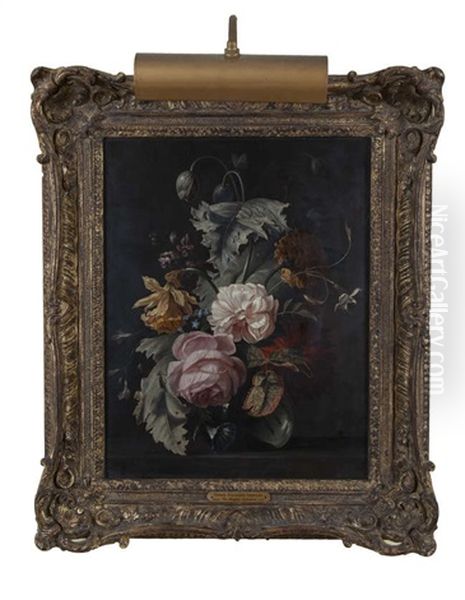
A pivotal moment in Verelst's life and career occurred around 1669 when he made the decision to relocate from The Hague to London. This move was not uncommon for Dutch artists during this period, as England, particularly after the Restoration of the monarchy in 1660 under King Charles II, offered new and potentially lucrative opportunities for patronage. London was becoming an increasingly important cultural and economic centre, attracting talent from across Europe.
Verelst's arrival in London coincided with a growing appreciation for Dutch art, especially still lifes and portraits, among the English aristocracy and burgeoning middle class. His skills, particularly in the detailed and illusionistic rendering of flowers, quickly found favour. He rapidly established himself within the London art scene, gaining access to influential patrons and circles.
His success was remarkable. He became highly sought after by the English nobility, receiving numerous commissions. Significantly, he gained favour at the court of King Charles II, a known patron of the arts. While the exact nature of his appointment isn't always specified with the same title, sources indicate he worked for the court, sometimes referred to as a court painter. This royal connection significantly boosted his prestige and earning potential. Verelst achieved considerable fame and financial success during his time in England, becoming one of the most fashionable painters of his speciality.
The 'God of Flowers' and Artistic Reputation
In London, Simon Verelst earned a striking nickname: the 'God of Flowers'. This title speaks volumes about the perceived mastery and perhaps the sheer impact of his floral still life paintings. His works were celebrated for their meticulous detail, vibrant colours, and an almost hyperrealistic quality that made the flowers seem tangible, possessing a remarkable three-dimensional presence on the canvas. He excelled at capturing the delicate textures of petals, the subtle play of light on leaves, and the transient beauty of blooms.
His technique involved careful layering of glazes to achieve luminosity and depth, a hallmark of Dutch fine painting (fijnschilder) traditions. The compositions, often featuring arrangements of tulips, roses, and other prized flowers in vases, were rendered with such precision that they seemed to surpass mere imitation and take on a life of their own. This illusionistic power was central to his appeal and likely contributed to the evocative 'God of Flowers' moniker.
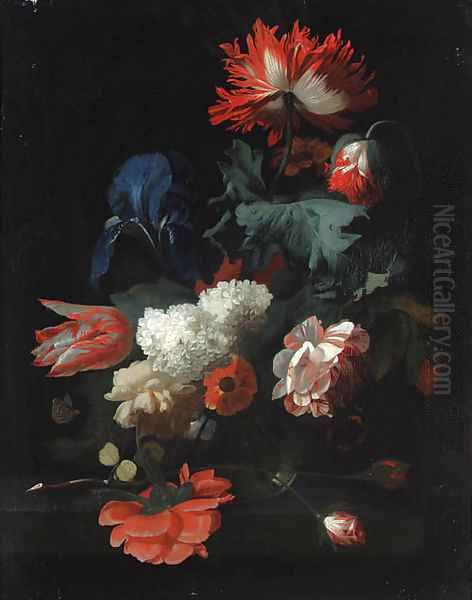
However, this very success and the accompanying adulation may have contributed to a controversial aspect of his personality. Contemporary accounts and later biographical records suggest that Verelst developed an extraordinary sense of vanity and self-importance, perhaps fuelled by his rapid ascent and the high prices his works commanded. His nickname, while complimentary, might also hint at an arrogance that became legendary.
Artistic Style and Technical Prowess
Simon Verelst's artistic output is primarily defined by his work in still life, particularly flower painting, but he was also a capable portraitist. His style is deeply rooted in the Dutch Golden Age tradition of meticulous realism and illusionism.
In his flower paintings, Verelst demonstrated an exceptional ability to render detail. Each petal, leaf, stem, and even the dewdrops often depicted on them, were executed with painstaking precision. He employed techniques of chiaroscuro, using strong contrasts between light and shadow, to model the forms and create a dramatic, almost tangible sense of volume. This gave his floral arrangements a striking three-dimensional quality, making them appear to project from the canvas. His colour palettes were typically rich and vibrant, capturing the natural hues of the flowers with intensity.
While influenced by the broader trends in Dutch still life, potentially looking towards artists like Willem van Aelst, Verelst developed a distinct style. Some critics noted his compositions could be quite bold, and his focus on rendering individual elements with hyper-fidelity was characteristic. This intense focus on detail, however, sometimes drew criticism, with some commentators suggesting that his works could become overly complex or fussy, potentially sacrificing overall harmony for intricate rendering.
His skill was not limited to flora. Verelst also undertook portrait commissions, a lucrative genre, especially in London. His portrait of Mary of Modena, the wife of James, Duke of York (later King James II), is often cited as a significant work. Such portraits demonstrate his ability to capture likenesses effectively and apply his mastery of light, shadow, and texture to human subjects and their attire, often incorporating floral elements that echoed his primary specialization.
Representative Works
Several key works exemplify Simon Verelst's style and contribution:
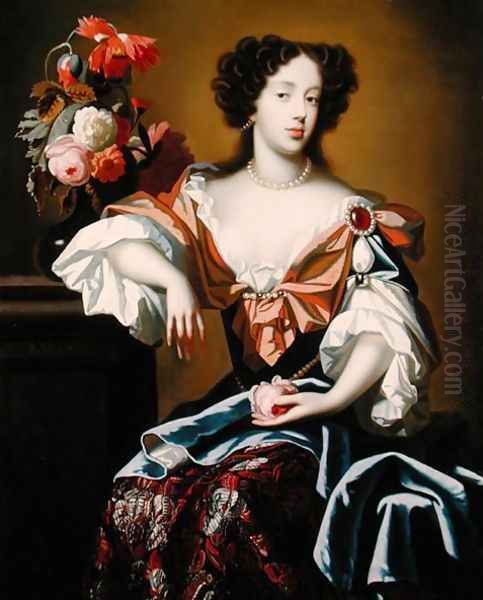
_Flower Piece_: This title likely refers to numerous works characteristic of his output. A typical Verelst Flower Piece would showcase a bouquet of meticulously rendered flowers, often including popular and exotic blooms like tulips and roses, arranged in a vase. These works are celebrated for their vibrant detail, illusionistic quality, and the skillful manipulation of light to create depth and texture, embodying the qualities that earned him his fame.
_Vase with Tulips_ : Dated around 1665, this painting, created before his move to London, already displays his burgeoning talent. It highlights his ability to handle complex arrangements and his sensitivity to colour contrasts and the specific forms of different flower types, particularly the prized tulip which was a recurring motif in Dutch art.
_Mary of Modena_: This portrait is one of his most recognized works outside the still life genre. As Duchess of York and later Queen Consort, Mary of Modena was a prominent figure. Verelst's portrait likely dates from his successful period in London. It showcases his ability to render not just the sitter's features but also the rich fabrics of her attire and jewellery, applying his characteristic attention to detail and sophisticated handling of light and shadow to the demands of court portraiture.
_Young Woman with a Bowl of Fruit_: Attributed to the early 18th century, this work suggests Verelst continued painting later in his life, possibly diversifying his subject matter slightly or combining figurative elements with still life. It demonstrates his enduring skill in rendering textures and forms, whether fruit, fabric, or flesh, maintaining the high level of finish associated with his name.
These works, held in various collections, serve as testaments to his technical skill and the particular aesthetic that captivated patrons in both the Netherlands and England.
Contemporaries and Artistic Network
Simon Verelst operated within a rich network of artists, both through family ties and professional interactions. His development and career were shaped by these connections.
The Verelst Dynasty:

His most immediate artistic circle was his family. His father, Pieter Hermansz. Verelst, provided his initial training. His brothers, Herman Verelst and Johannes Verelst, were fellow painters, creating a shared professional environment. Herman, who accompanied Simon to London, also achieved recognition, working in similar genres. The artistic lineage continued through Herman's daughter, Maria Verelst, who became a successful painter in England, known for her flower pieces and portraits, clearly influenced by the family tradition. The line extended further to Maria's son, Cornelis Verelst, and subsequently to Cornelis's son, William Verelst, who became a noted portrait painter in London in the 18th century. This family network highlights the continuity of artistic practice and shared stylistic concerns across generations.
Dutch Influences and Peers:
Beyond his family, Verelst was part of the broader Dutch Golden Age milieu. While specific direct interactions are not always documented in the provided sources, stylistic comparisons suggest connections. He may have been aware of or influenced by prominent still life painters active in the Netherlands. The source mentions Adriaen Pietersz. van de Venne as a painter with stylistic similarities, though Van de Venne was of an earlier generation and known more for genre scenes and allegories, albeit with detailed still life elements. A more direct influence or contemporary rival in the specific field of elaborate flower painting might have been Willem van Aelst, a leading figure known for his sophisticated compositions and exquisite technique, whose work Verelst would certainly have known. The garbled reference to "Pieter van der E..." might possibly allude to painters like Evert van Aelst, though Willem is a more prominent connection for high-end flower painting of this era.
London Connections and Legacy:
In London, Verelst interacted with patrons like the diarist Samuel Pepys and figures at the court of King Charles II. His success also placed him in a position of influence. Notably, the celebrated female flower painter Rachel Ruysch, one of the most successful female artists of the Dutch Golden Age, is mentioned as having received instruction from Verelst. This is a significant connection, linking Verelst directly to another major figure in the history of still life painting. Ruysch, in turn, went on to influence other artists, including figures like W. Ferguson (likely referring to William Gouw Ferguson, a Scottish painter active in Holland and England) and Elias van den Broeck, demonstrating the ripple effect of artistic influence originating from Verelst's practice and teaching.
Anecdotes, Personality, and Later Life
Simon Verelst's life seems to have been as colourful and dramatic as his paintings. Several anecdotes and biographical details paint a picture of a complex individual whose success was intertwined with personal challenges.
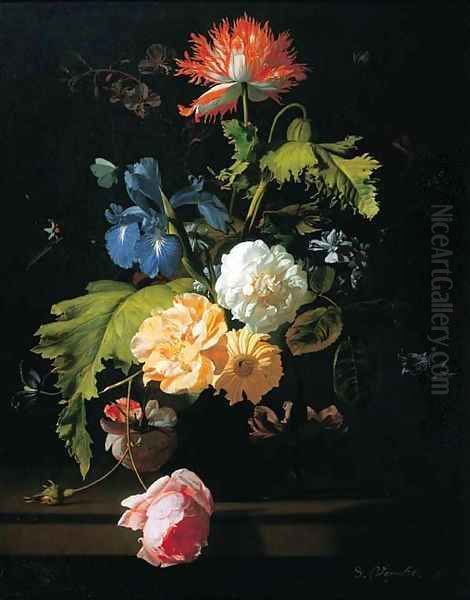
The meeting with Samuel Pepys on April 11, 1669, provides a specific glimpse into his early days in London. Pepys recorded in his famous diary that Verelst visited him, bringing a flower painting ('a little flower-pot') and asking a high price (£70), which Pepys considered excessive, though he admired the work. This encounter captures Verelst's confidence, perhaps already bordering on arrogance, regarding the value of his art shortly after his arrival.
His nickname, 'God of Flowers', while attesting to his skill, also became associated with his legendary vanity. Accounts suggest he carried his self-esteem to extremes, boasting of his talents and the high prices he commanded. This excessive pride reportedly led to mental instability. Sources mention that he suffered from periods of what might now be diagnosed as bipolar disorder or severe depression .
His mental health issues apparently became severe enough to require intervention. There are reports that Verelst was, at some point, confined to a mental institution due to his erratic behaviour and delusions of grandeur, sometimes referring to himself as the 'King of Painting'. This dramatic turn contrasts sharply with the image of the successful court artist.
Furthermore, despite the wealth he accumulated during his peak years, Verelst is said to have fallen into poverty later in life. The reasons for this decline are unclear but could be linked to his mental health struggles, changing fashions in art, or mismanagement of his finances. His final years are shrouded in some obscurity.
Even the date of his death is uncertain, with sources offering conflicting information, placing it either around 1710 or possibly as late as 1721. This ambiguity reflects the often-fragmentary nature of biographical records for artists of this period, particularly concerning their later, less prominent years.
Legacy
Simon Pietersz. Verelst left a distinct mark on the art history of both the Netherlands and England. As a Dutch Golden Age painter, he excelled in the highly valued genre of flower still life, contributing works of exceptional technical brilliance and illusionistic power. His paintings captured the era's fascination with botany, exoticism (especially tulips), and the vanitas theme – the transient beauty of flowers implicitly reminding viewers of the fleeting nature of life.
His move to London is significant as it represents the cross-cultural exchange that characterized the European art world. He successfully transplanted his Dutch style and skills into the English context, influencing tastes and possibly inspiring English artists. He catered to the demands of the Restoration court and aristocracy, demonstrating the international appeal of Dutch artistic conventions.
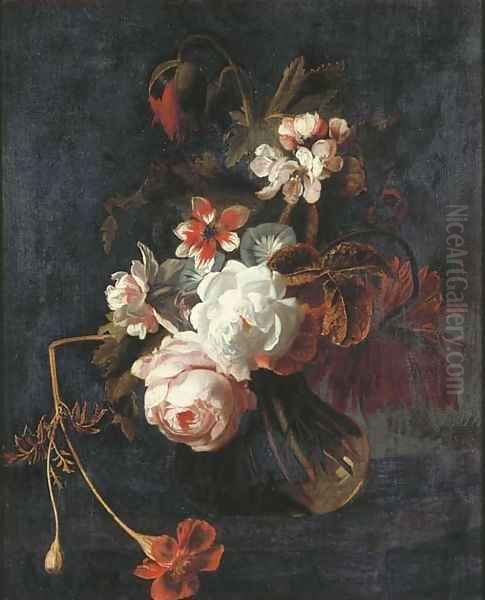
His legacy is complex. He is remembered for the sheer beauty and technical mastery of his floral paintings, which remain admired in museum collections today. He is also remembered through the anecdotes surrounding his personality – the 'God of Flowers' whose immense talent was matched by an equally immense ego, leading to personal tragedy. His role as a teacher, particularly to a major artist like Rachel Ruysch, also forms part of his contribution to the continuation of the flower painting tradition.
Despite criticisms of occasional over-elaboration, Simon Verelst's best works stand as prime examples of late 17th-century flower painting, embodying the precision, richness, and dramatic flair that defined the high point of this genre during the Dutch Golden Age and its successful transplantation abroad. He remains a fascinating figure, representing both the pinnacle of artistic achievement and the personal costs that sometimes accompany genius and fame.